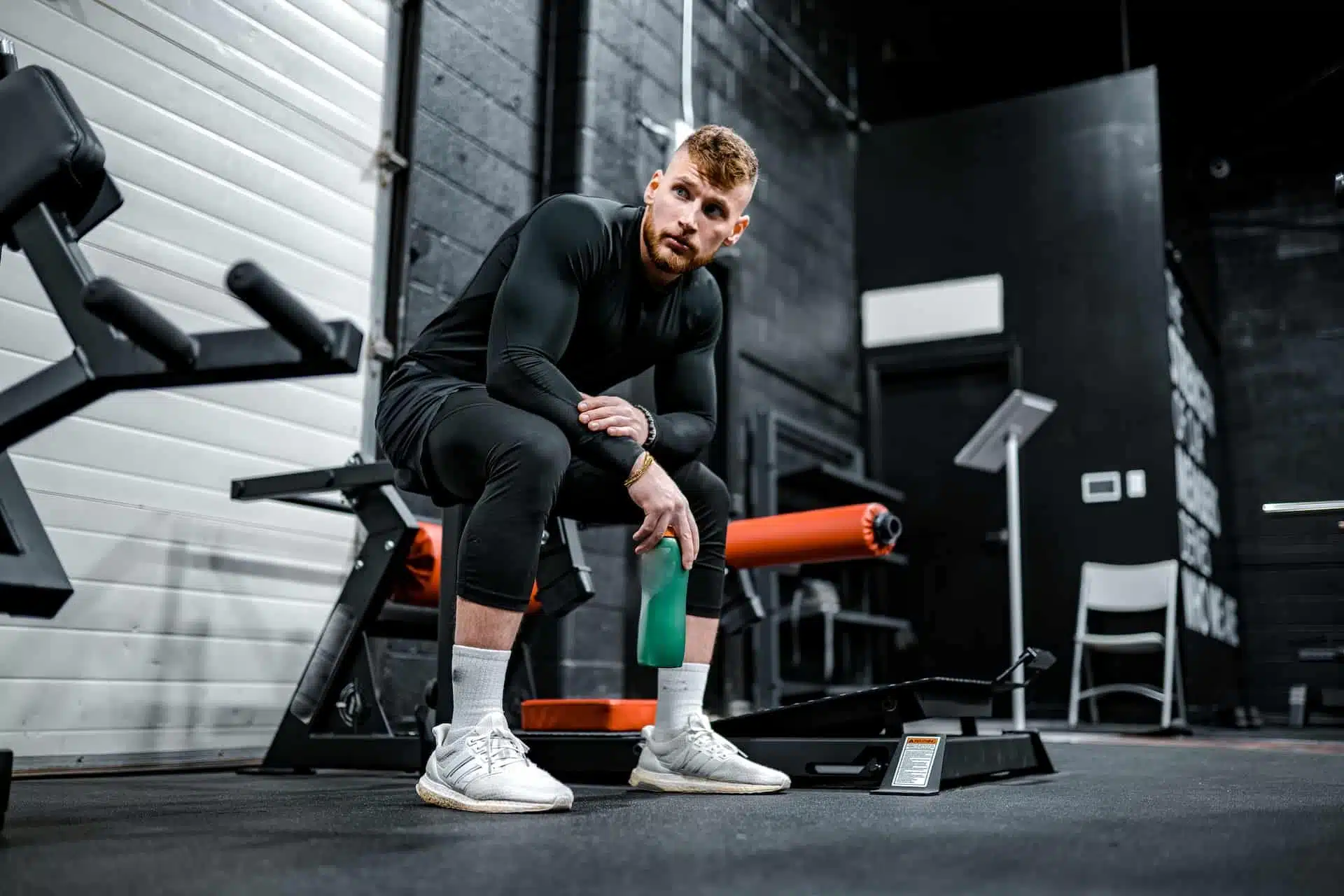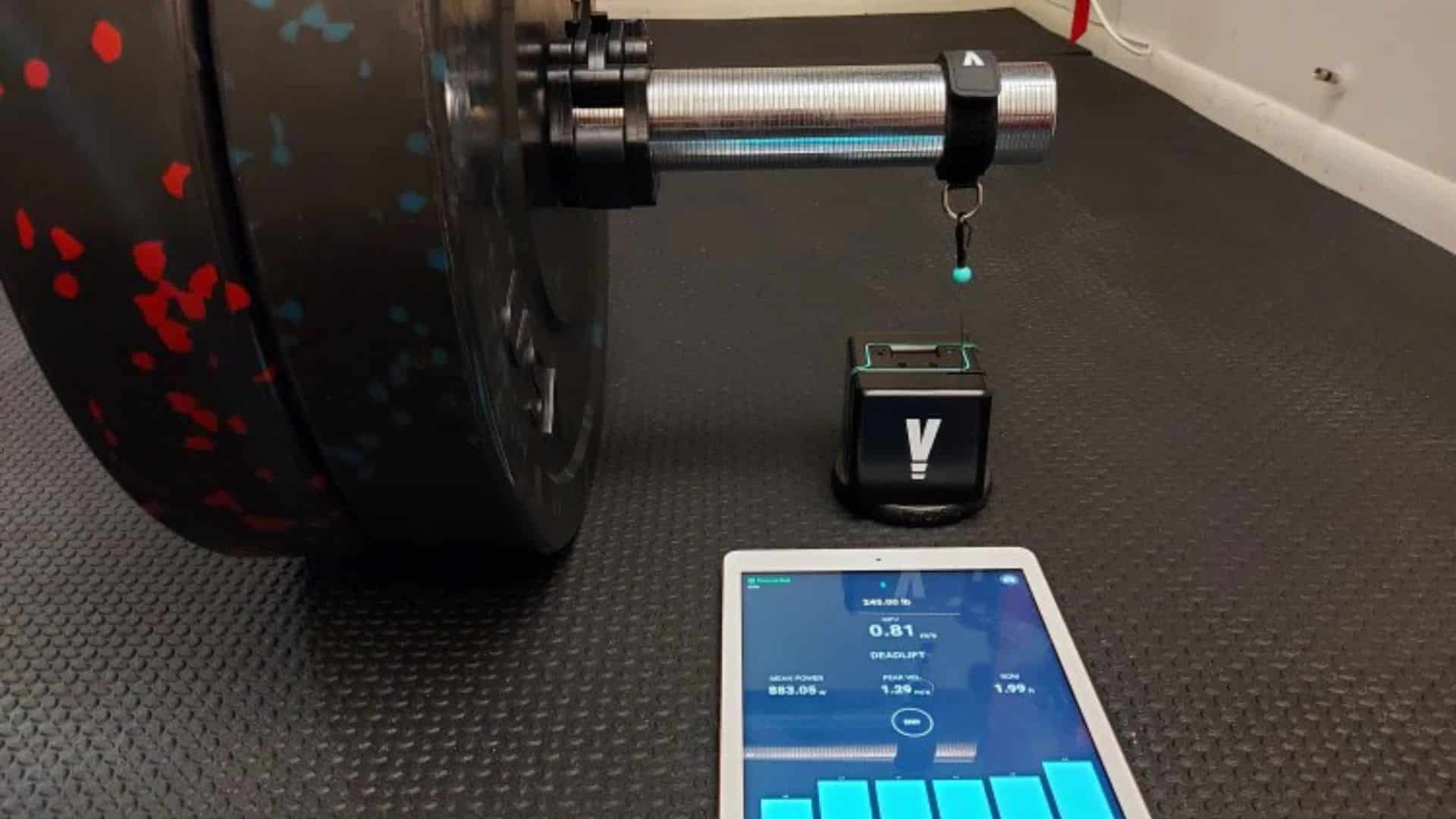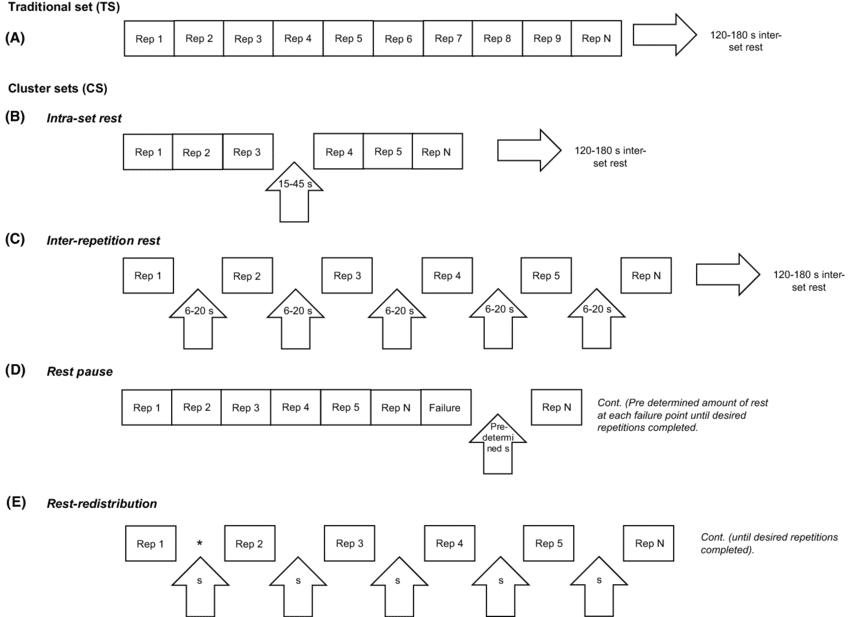6 de November de 2023
Rest Pause Training Method For Strength & Muscle
Rest-Pause Training: The Art of Resting Within the Set

In strength training program design, numerous variables are manipulated to achieve goals such as intensity, volume, and frequency. One of these variables is the rest time between sets, which can significantly impact how well we approach the next set. Traditional strength training prescription has focused on continuous sets with rest intervals implemented after completing each set. The rest-pause technique involves continuing to perform extra repetitions beyond muscle failure by introducing short rest intervals of 10 to 20 seconds within the set, without reducing the load. Thanks to these brief rest periods, it becomes possible to complete a higher number of repetitions with a load that would typically allow only half, as each time we reach muscle failure, we introduce a short break and continue with the set to perform additional repetitions.

Strength & Conditioning Program
Scientific literature has shown that the rest-pause technique has a more significant effect on muscle hypertrophy compared to traditional training methods. Significant gains in strength and muscle mass have also been observed when using advanced techniques similar to rest-pause, although they may not be identical. Throughout this article, we will delve into what the rest-pause method entails, how to use it, and its alternatives that are beneficial for gaining strength and muscle mass.
Why is a 20-Second Rest Used in the Rest-Pause Technique?
We have different energy systems at our disposal depending on the demands we place on our body. Running a 100-meter sprint is vastly different from a 100-kilometer race. In strength training, our primary energy source is the phosphagen system, specifically muscular phosphocreatine. This energy reserve is depleted within seconds when high-intensity efforts are demanded but can recover significantly within 20 seconds, allowing us to use it again (Green et al., 2014).
However, the complete recovery of muscular phosphocreatine doesn’t occur within this short timeframe. To achieve full recovery, we need three minutes or more. This is why high-intensity workouts or power training recommend a minimum rest of three minutes. Nevertheless, those 20 seconds serve as a “quick charge” that enables us to perform extra repetitions after reaching muscular failure in the previous set.
Why Use the Rest-Pause Technique?
The goal of this advanced training technique is to increase mechanical tension during the set, a fundamental mechanism for gaining muscle mass (B. Schoenfeld, 2011). In addition, adding extra repetitions near muscular failure offers additional advantages, such as introducing more volume in the session and increasing the likelihood of recruiting and fatiguing additional muscle fibers, especially those with a high recruitment threshold.
On the other hand, rest-pause training may not be optimal due to the high fatigue it generates. Instead, we can utilize other advanced techniques that also divide the set into multiple blocks of repetitions. This allows us to perform each repetition with the utmost quality, getting the most out of each one. In the section on “training with the rest-pause technique to gain muscular strength and power,” we will explore the cluster set method, which includes rest-pause and two other training options
Repetition Count in the Rest-Pause Technique

“The rest-pause technique involves lifting a specific weight to exhaustion, typically with the goal of performing between 10 and 12 repetitions, followed by a short rest interval, usually between 10 and 20 seconds, and then performing as many repetitions as possible until reaching muscle failure. This process is repeated as needed to achieve the total number of predetermined repetitions (Marshall et al., 2012).
The rest-pause method sets a higher number of repetitions than one could perform using the traditional approach (Enes et al., 2021). For example, with the rest-pause method, you might complete 20 or more repetitions with the weight that would typically lead to muscle failure at 10-12 repetitions. The brief rest time upon reaching muscle failure provides a brief respite that allows you to squeeze out more repetitions (Marshall et al., 2012). Let’s consider the following example, although it can be applied to high, medium, or low repetitions:
- Select a weight that allows you to perform between 10 and 12 repetitions, even though your goal is to complete 20 repetitions with that weight.
- Perform as many repetitions as possible until reaching muscle failure, which should be within the range of 10 to 12 repetitions. Let’s assume you complete 11 repetitions.
- Rest for 15 seconds (or the duration of your choice between 10 and 20 seconds).
- Perform as many repetitions as you can again. Let’s say you manage to complete 5 repetitions, adding to the previous 11, for a total of 16 repetitions.
- Rest for another 15 seconds (or within your chosen range of 10 to 20 seconds).
- Once again, perform as many repetitions as you can. Let’s imagine you complete four repetitions, bringing the total to 20 repetitions (11 in the first block + 5 in the second block + 4 in the third block).
- If you don’t reach 20 repetitions in that final set, rest and repeat the cycle until you achieve the fixed number of repetitions.
Rest-Pause Training Offers a Wide Range of Repetitions and Options
The dynamics of rest-pause training are always the same: perform repetitions to muscle failure, rest, continue with repetitions, rest… until you complete a predetermined number of repetitions or blocks. With this protocol, you can create the training that suits you best. One of them is the so-called “infinite set,” in which you perform repetitions with one hand or leg to muscle failure, and while that hand or leg has a brief rest, you train the other hand or leg. Alternate between limbs so that the training of one hand or leg serves as the rest for the other.
You can try the “widowmaker” technique, where you set a high number of repetitions, which can even be 100, with a weight that allows only a few repetitions, such as 15 or 20 in this example. This way, you manage your rests until you complete all the repetitions. Another option is to take one breath for each repetition, meaning one repetition, rest with one long breath, two repetitions, rest with two long breaths, and so on, increasing one breath for each repetition.
Borge Fagreli’s “myo-reps” offer another example of the wide range of rest-pause training that you can create. In this case, there are different proposals in which you will perform a predetermined number of repetitions and reach muscle failure as many times as the program indicates. Here are some examples of Borge Fagreli’s “myo-reps”:
- A load of 50-55% to perform 20-25 repetitions to muscle failure and 15 myo-reps, meaning 15 extra repetitions reaching failure as many times as needed. For example, you can do six repetitions after muscle failure, then five, and then four, thus completing the 15 prescribed repetitions after the initial muscle failure.
- A load of 60-65% to perform between 15 and 20 repetitions to muscle failure and 16 myo-reps. You already know how they work: reach failure as many times as needed to complete 16 repetitions after the initial muscle failure.
- A load of 70% to perform between 12 and 15 repetitions + 15 myo-reps.
- A load of 75% to perform between 10 and 12 repetitions + 15 myo-reps.
- A load of 80% to perform between 8 and 10 repetitions + 14 myo-reps.
- A load of 85% to perform between 6 and 8 repetitions + 8 myo-reps.

Velocity Loss and Fatigue
Training with the Pause Rest Technique for Muscle Hypertrophy

Muscle hypertrophy induced by strength training is a phenomenon that occurs when protein synthesis exceeds protein degradation (Joanisse et al., 2020). The magnitude of morphological adaptations is inversely proportional to the athlete’s training level. The higher the level, the more challenging it is to increase muscle mass, and it is achieved to a lesser extent. This is why intermediate and advanced bodybuilders seek special techniques to increase session intensity, volume, and density. Among these advanced techniques, you can find the pause rest method, along with others such as drop-sets, eccentric overload, and many more (Kassiano et al., 2021).
More Volume, More Muscle Hypertrophy
Some studies have observed significant increases in muscle size after using an advanced technique like rest-pause, although one of the reasons is that the volume performed per session was higher (Kassiano et al., 2021). Knowing that volume is the main variable for gaining muscle mass, performing more repetitions or sets with the rest-pause technique logically results in greater muscle mass gains (B. Schoenfeld & Grgic, 2018).
To eliminate the confounding factor of volume, several studies compared traditional training to the rest-pause technique, while equating the total volume. The results showed that both methods generate similar changes in muscle mass gain in the observed muscle groups (Prestes et al., 2019). These findings lead us to think that, more than the rest-pause technique itself, or any other advanced technique, what matters for gaining muscle mass is the total training volume. In this line, the rest-pause technique, along with others like drop-sets, allows for incorporating much more volume in the same session time, or achieving the same volume in much less time, which is referred to as density.
Hormones in Rest-Pause Training
A recent study showed that rest-pause training increased the levels of hormones associated with muscle growth, such as insulin-like growth factor-1 (IGF-1), to a greater extent than traditional strength training, but the differences were not significant (Karimifard et al., 2023). The metabolic stress and mechanical tension generated by rest-pause training can lead to increased muscle mass by altering the release of myokines that promote anabolism or muscle growth (Prestes et al., 2019; B. J. Schoenfeld, 2013). However, more research is needed on the effects of rest-pause training versus the traditional system regarding hormonal adaptations to draw valid conclusions.
Training with the Rest-Pause Technique to Gain Muscle Strength and Power

While Rest-Pause Training appears to be a successful strategy for gaining muscle mass, especially if we manage to increase the total volume, the association is different when it comes to strength. Scientific literature does not observe significant favorable differences in the use of the Rest-Pause Technique compared to traditional training for gaining muscle strength and power. In fact, Rest-Pause Training until muscle failure on several occasions within the same set generates very high fatigue in athletes. This fatigue is reflected in a lower jump height and acute neuromuscular dysfunction, which would require a long time to return to normal strength values. What if we use the Rest-Pause Technique but don’t go to muscular failure? This is the ace up the sleeve that makes techniques like clustering (group sets) one of the best strategies for gaining strength and power. Let’s see why.

1RM Calculator
Traditional Sets vs. Cluster Sets, Including the Rest-Pause Technique
Relatively new strategies, such as cluster sets or group series, have sparked great interest for their ability to maximize neuromuscular adaptations, provide overload, maintain training intensity, and minimize overtraining (Tufano et al., 2017). You can delve into more detail on the cluster method in this previous article on our blog, as we will only briefly cover it here.
Within cluster sets or group series, there are three types of groupings: intra-set rest, inter-repetition rest, and the rest-pause technique. In the following image taken from Latella et al. (2019), you can see cluster sets and a comparison with traditional sets with various random examples of repetitions that we could prescribe.

So far, we’ve exclusively discussed the rest-pause technique, which is the most interesting for gaining muscle mass. In the lower part of the image above, you can visualize an example of rest-pause in which we perform repetitions until muscular failure, rest for 20 seconds, and continue doing repetitions. In this example, we complete six consecutive repetitions to muscle failure, take a brief pause, and then continue until muscular failure again.
When it comes to gaining strength and power, it’s preferable to use the between-set and between-repetition rest methods. In the image above, you can see an example of a traditional set in which we perform 10 consecutive repetitions, after which we introduce the necessary rest. Within cluster sets, there is first the between-set rest method, in which we do six sets divided into two blocks with 20 seconds of rest between them, and the between-repetition rest method, in which we take a break after each repetition. The example in the image demonstrates how we divide six repetitions into six blocks of a single repetition, each followed by six seconds of rest.
The rest-pause and the rest within the set and between-repetition methods are essentially group repetition training methods, similar to cluster sets, but with some variations, such as not reaching muscular failure in each set and primarily using low repetitions. The rest of the methodology is identical, as it incorporates short rest periods within the set, dividing the total number of repetitions into smaller repetition groups (Latella et al., 2019). For example, instead of doing a traditional set of six repetitions (1 x 6), the rest between sets divides those six repetitions into two blocks of three or three blocks of four, so 1 x 6 becomes 2 x 3 or 3 x 2, introducing rests within the set based on our needs. You can also use the between-repetition rest method in which you do 6 x 1, meaning one repetition, rest, another repetition, rest, and so on.

Best Velocity Based Training Devices – Full Review 2025
More Rest, More Quality in Each Repetition, and More Strength and Power
The reason for training with rest-pause methods within the set and between repetitions, rather than with the rest-pause technique, is that the loss of speed and power in the set is much less than what you would find in a traditional set or a rest-pause set. Imagine loading your barbell for six repetitions and doing them all in a row. The first repetition will be fast, the second slower, and so on until the last one where the speed will be much lower. Now, imagine that instead of doing all six repetitions in a row, you’re going to do three sets of two repetitions, and you’re going to rest 20 seconds between them.
- Do two repetitions
- Rest for 20 seconds
- Do two repetitions
- Rest for 20 seconds
- Do two repetitions, and the set is finished because you’ve completed the six prescribed repetitions
- Rest for three minutes, and then repeat.
In this way, the lost speed will be much lower, leading to higher training quality and less fatigue. You can objectively observe this with a velocity measurement device like the one from Vitruve, which shows you in real time the speed at which you’ve moved the bar in each repetition. If your goal is to work on power, this training model becomes even more important. There’s a significant difference between performing four consecutive jumps without a pause and taking a 10-second break after each jump. Accumulated fatigue will be much lower, speed and jump height will be higher, and neuromuscular adaptations will also be greater (Latella et al., 2019).
Therefore, the pure rest-pause technique, where you reach muscular failure and work with great fatigue, is very interesting for gaining muscle mass. However, if you’re aiming for strength and power, you should adapt it to a type of cluster set that is far from muscular failure and ensure each repetition is of the highest possible quality, such as training with rest within the set or rest between repetitions.

Velocity Based Training 【 #1 VBT Guide in the World 】
References
Enes, A., Alves, R. C., Schoenfeld, B. J., Oneda, G., Perin, S. C., Trindade, T. B., Prestes, J., & Souza-Junior, T. P. (2021). Rest-pause and drop-set training elicit similar strength and hypertrophy adaptations compared with traditional sets in resistance-trained males. Https://Doi.Org/10.1139/Apnm-2021-0278, 46(11), 1417–1424. https://doi.org/10.1139/APNM-2021-0278
Green, L. A., Parro, J. J., & Gabriel, D. A. (2014). Beneficial effects of serial contractions on muscle performance after a brief period of rest. European Journal of Applied Physiology, 114(8), 1657–1665. https://doi.org/10.1007/s00421-014-2896-8
Joanisse, S., Lim, C., McKendry, J., Mcleod, J. C., Stokes, T., & Phillips, S. M. (2020). Recent advances in understanding resistance exercise training-induced skeletal muscle hypertrophy in humans. F1000Research, 9. https://doi.org/10.12688/F1000RESEARCH.21588.1/DOI
Karimifard, M., Arazi, H., & Mehrabani, J. (2023). Twelve Weeks Rest–Pause and Traditional Resistance Training: Effects on Myokines and Performance Adaptations among Recreationally Trained Men. Stresses 2023, Vol. 3, Pages 302-315, 3(1), 302–315. https://doi.org/10.3390/STRESSES3010022
Kassiano, W., De Vasconcelos Costa, B. D., Nunes, J. P., Aguiar, A. F., De Salles, B. F., & Ribeiro, A. S. (2021). Are We Exploring the Potential Role of Specialized Techniques in Muscle Hypertrophy? International Journal of Sports Medicine, 42(6), 494–496. https://doi.org/10.1055/A-1342-7708
Korak, J. A., Paquette, M. R., Brooks, J., Fuller, D. K., & Coons, J. M. (2017). Effect of rest-pause vs. traditional bench press training on muscle strength, electromyography, and lifting volume in randomized trial protocols. European Journal of Applied Physiology, 117(9), 1891–1896. https://doi.org/10.1007/S00421-017-3661-6/METRICS
Latella, C., Teo, W. P., Drinkwater, E. J., Kendall, K., & Haff, G. G. (2019). The Acute Neuromuscular Responses to Cluster Set Resistance Training: A Systematic Review and Meta-Analysis. Sports Medicine, 49(12), 1861–1877. https://doi.org/10.1007/S40279-019-01172-Z/FIGURES/4
Marshall, P. W. M., Robbins, D. A., Wrightson, A. W., & Siegler, J. C. (2012). Acute neuromuscular and fatigue responses to the rest-pause method. Journal of Science and Medicine in Sport, 15(2), 153–158. https://doi.org/10.1016/J.JSAMS.2011.08.003
Prestes, J., A Tibana, R., de Araujo Sousa, E., da Cunha Nascimento, D., de Oliveira Rocha, P., F Camarço, N., Frade de Sousa, N. M., & Willardson, J. M. (2019). Strength and Muscular Adaptations After 6 Weeks of Rest-Pause vs. Traditional Multiple-Sets Resistance Training in Trained Subjects. Journal of Strength and Conditioning Research, 33, S113–S121. https://doi.org/10.1519/JSC.0000000000001923
Schoenfeld, B. (2011). The use of specialized training techniques to maximize muscle hypertrophy. Strength and Conditioning Journal, 33(4), 60–65. https://doi.org/10.1519/SSC.0B013E3182221EC2
Schoenfeld, B., & Grgic, J. (2018). Evidence-based guidelines for resistance training volume to maximize muscle hypertrophy. Strength and Conditioning Journal, 40(4), 107–112. https://doi.org/10.1519/SSC.0000000000000363
Schoenfeld, B. J. (2013). Potential Mechanisms for a Role of Metabolic Stress in Hypertrophic Adaptations to Resistance Training. Sports Medicine 2013 43:3, 43(3), 179–194. https://doi.org/10.1007/S40279-013-0017-1
Todd, J. S., Shurley, J. P., & Todd, T. C. (2012). Thomas L. DeLorme and the science of progressive resistance exercise. Journal of Strength and Conditioning Research, 26(11), 2913–2923. https://doi.org/10.1519/JSC.0B013E31825ADCB4
Tufano, J. J., Brown, L. E., & Haff, G. G. (2017). Theoretical and Practical Aspects of Different Cluster Set Structures: A Systematic Review. Journal of Strength and Conditioning Research, 31(3), 848–867. https://doi.org/10.1519/JSC.0000000000001581

